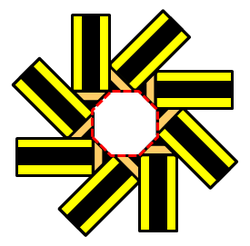It All Came From Pencils 4
 Hazri made another 2
pencilogons
using
and
identical pencils with pencil tips of angle
and
respectively (
).
Hazri made another 2
pencilogons
using
and
identical pencils with pencil tips of angle
and
respectively (
).
If can be expressed as where is a positive real number, and , then the maximum value of is...?
(Assume the pencils have a rectangular body and have their tips resembling isosceles triangles)
This is one part of 1+1 is not = to 3 .
The answer is 123.
This section requires Javascript.
You are seeing this because something didn't load right. We suggest you, (a) try
refreshing the page, (b) enabling javascript if it is disabled on your browser and,
finally, (c)
loading the
non-javascript version of this page
. We're sorry about the hassle.
Suppose the interior angles of p - pencilogon is u , the interior angles of q - pencilogon is v ( u , v is a positive real number), it's not hard ot show that the interior angles of the pencilogon are 1 8 0 ∘ − 2 x . We have 1 8 0 ∘ − 2 α = u α = 2 ( 1 8 0 ∘ − u ) 1 8 0 ∘ − 2 β = v β = 2 ( 1 8 0 ∘ − v ) β − α = 2 ( u − v ) = 2 k ∴ u − v = k Hence, β α = 1 8 0 ∘ − v 1 8 0 ∘ − u = 1 8 0 ° − 6 1 k 1 8 0 ° − 6 2 k − ( u + 6 1 k ) 1 8 0 ° + 6 1 u k = − ( v + 6 2 k ) 1 8 0 ° + 6 2 v k ( u − v − k ) 1 8 0 ° = ( 6 1 u − 6 2 v ) k ( 6 1 u − 6 2 v ) k = 0 Since k = 0 , 6 1 u − 6 2 v = 0 and we conclude v u = 6 1 6 2 .
Since the ratio of the interior angles of p - pencilogon to the interior angles of q - pencilogon is 6 1 6 2 , q ( q − 2 ) × 1 8 0 ∘ p ( p − 2 ) × 1 8 0 ∘ = 6 1 6 2 p ( q − 2 ) q ( p − 2 ) = 6 1 6 2 6 1 q ( p − 2 ) = 6 2 p ( q − 2 ) 6 1 p q − 1 2 2 q = 6 2 p q − 1 2 4 p 1 2 2 q = 1 2 4 p − p q = p ( 1 2 4 − q )
As q > 0 , 1 2 2 q > 0 , so p ( 1 2 4 − q ) > 0 , q < 1 2 4 , therefore, the maximum value of q is 1 2 3 .